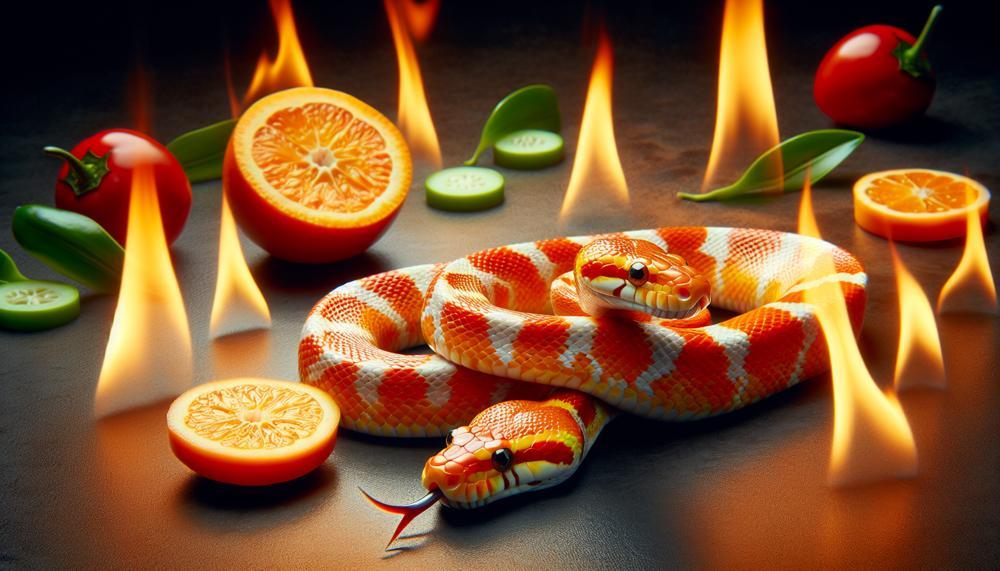Imagine a world where snakes can survive without heat.
Sounds like something out of a sci-fi movie, right? But in reality, there is one species of snake that has this incredible ability – the corn snake.
These mesmerizing creatures have captured the attention of many with their striking colors and patterns, but it’s their unique survival skill that truly sets them apart. You may be wondering how a cold-blooded animal can thrive without warmth, and that’s exactly what we’ll explore today.
So, can corn snakes live without heat?
Corn snakes can survive without a heat lamp for a short time, depending on the room temperature. For example, if the room temperature is around 70-75°F, a corn snake might be able to go for a few days without a heat lamp.
Most experts agree that corn snakes can thrive in a habitat with a temperature range of around 70°F to 88°F. The cool side of the cage shouldn’t fall below 70°F, and the warmer / basking side shouldn’t get hotter than 88°F. Night temps should never be lower than 75°F.
Corn snakes need some heat to help them digest food. Snakes need warmth to charge the metabolism. Reptile bodies can freeze completely, leading to death. Chronic hypothermia negatively impacts the reptile’s immune system which can lead to secondary infections.
Let’s dive in now.
Contents
Importance of Heat for Corn Snakes
The lack of heat can have serious implications for the physical and mental well-being of corn snakes.
Being ectothermic creatures, they depend on external heat sources to regulate their body temperature and carry out important bodily processes. Without adequate warmth, corn snakes are at risk of a compromised immune system, difficulty shedding, weight loss, and even aggression.
While it is possible for them to survive without heat, it is not advisable for their overall health and vitality as they require optimal temperatures to flourish.
Factors Affecting a Corn Snake’s Ability to Survive Without a Heat Lamp
When it comes to a corn snake’s ability to survive without a heat lamp, there are several key environmental factors that come into play. These include the ambient temperature, humidity levels, the size and age of the snake, and even the region in which it originates from.
It’s important to understand how each of these factors plays a role in the overall well-being of your corn snake, and how they can affect its ability to thrive in its environment.
- Firstly, let’s take a closer look at ambient temperature. Corn snakes are ectothermic creatures, meaning they rely on external heat sources to regulate their body temperature. In their natural habitat, they would bask in the sun or seek out warm spots to warm up. However, in captivity, this is not always possible. Without a heat lamp, your corn snake may struggle to maintain its body temperature, which can lead to health issues and even death.
- Humidity levels are another crucial factor when it comes to a corn snake’s survival without a heat lamp. These snakes require a certain level of humidity to properly shed their skin and maintain healthy respiratory function. Without enough humidity, they may experience difficulty shedding or develop respiratory infections.
- The size and age of your corn snake also play a significant role in its ability to survive without a heat lamp. Younger snakes may be more sensitive to changes in temperature and humidity, while larger snakes may require more heat to maintain their body temperature.
- Finally, the region where your corn snake originates from can also impact its ability to thrive without a heat lamp. Corn snakes from warmer regions may have adapted better to lower temperatures, while those from cooler regions may require more heat to stay healthy.
How Long Can a Corn Snake Go Without a Heat Lamp?

While a heat lamp is not crucial for the survival of a corn snake, it plays a significant role in their overall care. Corn snakes are ectothermic creatures, meaning they rely on external temperatures to regulate their body temperature. In the wild, they would soak up the sun’s warmth and find shelter to cool down. As responsible pet owners, it is our duty to provide them with an optimal environment to thrive.
A heat lamp can be utilized to create a basking spot for the snake, mimicking their natural behavior. However, it must be used in conjunction with other heat sources and controlled by a thermostat to prevent overheating or burning the snake. Alternative heat sources include heat mats, heat tape, ceramic heat emitters, or loose substrates such as aspen shavings or cypress mulch.
Although a heat lamp can be beneficial for a corn snake’s well-being, they can go without one for short periods. As long as the enclosure maintains a temperature gradient and stays within the recommended range of 75-85° degrees Fahrenheit (24-29° C), a corn snake can survive without a heat lamp for a few days.
However, sudden drops in temperature or consistent fluctuations can have negative impacts on the snake’s health. Therefore, it is essential to have alternative heating methods in place in case of power outages or other unexpected situations. Additionally, turning off the heat lamp at night is crucial to allow the snake to rest and maintain its circadian rhythm.
Precautions and Considerations for Heat Lamp Usage
When using a heat lamp for a corn snake, there are several crucial factors to keep in mind. These include the type of heat source, temperature control, and monitoring the snake’s behavior.
By following proper precautions and considerations, you can create a comfortable and safe environment for your snake to flourish in.
Type of Heat Source:
The type of heat source used is an important aspect to consider when using a heat lamp for a corn snake. While heat mats or tapes can provide supplemental heat, a heat lamp is a popular choice due to its ability to create a temperature gradient within the snake’s cage.
However, caution must be exercised when using under-tank heating devices as they can potentially damage the cage if they become too hot. It is recommended to use a rheostat to control the output of any heating device and prevent accidents.
Temperature Control:
Maintaining the correct temperature range is crucial for a corn snake’s well-being. The ideal temperature range for a corn snake is between 70°F to 88°F (21°C to 31°C). This can be achieved by combining heat sources, such as a heat lamp and under-tank heating device.
Regularly monitoring the temperature and making adjustments as needed is important. A stick-on thermometer strip or temperature gun can be used to measure the temperature inside the cage.
Behavior Monitoring:
Monitoring the snake’s behavior is another vital aspect when using a heat lamp for a corn snake. As ectothermic creatures, snakes rely on external sources of heat to regulate their body temperature.
If the temperature is too low, they may become sluggish or refuse to eat, while if it is too high, they may become stressed or dehydrated.
By regularly observing your snake’s behavior and making necessary adjustments to the temperature range, you can ensure their well-being and prevent potential health issues.
Also Read:
Conclusion
In a world where warmth is vital for survival, the corn snake defies all odds by thriving without heat. This unique ability has captured the attention of many and sparked curiosity about how these mesmerizing creatures can survive in such conditions.
However, as we have discovered in this article, while it is possible for corn snakes to live without heat, it is not recommended for their overall health and well-being.
Factors such as ambient temperature, humidity levels, size and age of the snake, and its origin all play a crucial role in its ability to survive without a heat source. It is important to understand these factors and provide a suitable environment with proper heating options for your pet snake.
While a heat lamp may not be necessary for their survival, it still plays an important role in their care and should not be overlooked.
But don’t just take our word for it – observe the natural habitat of corn snakes. In the wild, they are often found basking in the sun or seeking out warm areas to regulate their body temperature.
This shows that while they may have adapted to survive without external heat sources, they still rely on them for optimal health.






